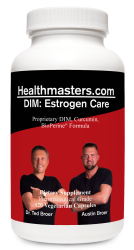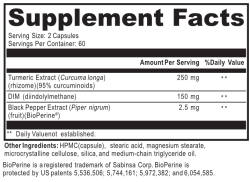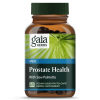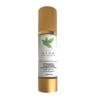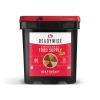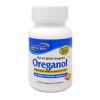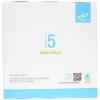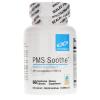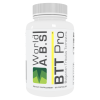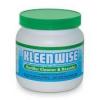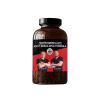Dimension: Estrogen Control
Applications for Health Improvement
- Supports healthy estrogen metabolism in women and men
- Supports detoxification of xenoestrogens
- Provides support for antioxidant mechanisms
120 Vegetarian Capsules
Our Dimension formula represents a three-dimensional approach to supporting healthy estrogen metabolism. Can be used by both women and men for the management of estrogen dominant conditions, Beneficial for individuals experiencing high estrogen, endometriosis, uterine fibroids, ovarian cysts, fibrocystic breasts, hypothyroidism, insomnia, autoimmune disorders and hair loss. Research suggests that diindolylmethane (DIM), curcumin (from turmeric extract), and the patented black pepper extract BioPerine® support balanced estrogen metabolism.
DIM (3,3’-diindolylmethane) is the stable, bioactive metabolite formed when stomach acid breaks down indole-3-carbinol (I3C), a sulfur-containing glucosinolate present in cruciferous vegetables [1]. Supplementation with DIM is preferred over I3C due to I3C’s undesirable breakdown products, including the dioxin-like molecule indolo[3,2-b]carbazole (ICZ) [2]. DIM has been found to support hormone metabolism and immune activity and stimulate antioxidant and detoxification systems [3]. Healthy metabolism of exogenous and endogenous estrogens can be pivotal for hormonal balance [4]. DIM promotes metabolism of estrogen into the favorable and protective 2-hydroxyestrone (2-OHE) metabolite versus production of 4-hydroxyestrone (4-OHE) and 16-alpha-hydroxyestrone (16-alphaOHE) metabolites [5]. DIM has been studied for its role in supporting prostate health as well, by reducing dihydrotestosterone binding to androgen receptors [6,7].
This formula also provides support for both antioxidant and detoxification systems which, in turn, support cellular function and integrity. Antioxidant activity is crucial to counteracting oxidative molecules normally produced during phase I detoxification. Research on DIM suggests that it plays an important role in activating detoxification enzymes in human hepatocytes, further supporting biotransformation at a primary site in the body [8].
Curcumin: As the major curcuminoid found in turmeric, curcumin is valued for its promotion of antioxidant activity, support of metabolic detoxification, and modulation of cytokine production [9]. Research studying genotoxic estrogen metabolites suggests that curcumin’s inhibitory effect on anchorage-independent growth and on CYP enzymes following dioxin exposure helps support healthy cell-life regulation in human embryonic kidney cells and normal prostate cells [10]. BioPerine® is a patented form of piperine, the main alkaloid from black and long pepper plants that has been found to effectively support the absorption of nutrients. After a dose of 2 g of curcumin, human serum levels of curcumin were either undetectable or very low. When the same dose was given along with 20 mg of piperine (4:1 ratio), there was a 2000% increase in the bioavailability of the curcumin without adverse effects [11].
CAUTIONS: Individuals taking medication, especially blood thinners or cancer treatment, should discuss potential interactions with their healthcare practitioner.
References
- Bradlow HL. Review. Indole-3-carbinol as a chemoprotective agent in breast and prostate cancer. In Vivo. 2008 Jul-Aug;22(4):441-5. [PMID: 18712169]
- Herrmann S, Seidelin M, Bisgaard HC, et al. Indolo[3,2-b]carbazole inhibits gap junctional intercellular communication in rat primary hepatocytes and acts as a potential tumor promoter. Carcinogenesis. 2002 Nov;23(11):1861-8. [PMID: 12419834]
- Riby JE, Xue L, Chatterji U, et al. Activation and potentiation of interferongamma signaling by 3,3'-diindolylmethane in MCF-7 breast cancer cells. Mol Pharmacol. 2006 Feb;69(2):430-9. [PMID: 16267208]
- Lord RS, Bongiovanni B, Bralley JA. Estrogen metabolism and the diet-cancer connection: rationale for assessing the ratio of urinary hydroxylated estrogen metabolites. Altern Med Rev. 2002 Apr;7(2):112-29. [PMID: 11991791]
- Cavalieri E, Frenkel K, Liehr JG, et al. Estrogens as endogenous genotoxic agents--DNA adducts and mutations. J Natl Cancer Inst Monogr. 2000;(27):75- 93. [PMID: 10963621]
- Fares F, Azzam N, Appel B, et al. The potential efficacy of 3,3'-diindolylmethane in prevention of prostate cancer development. Eur J Cancer Prev. 2010 May;19(3):199-203. [PMID: 20010430]
- Le HT, Schaldach CM, Firestone GL, et al. Plant-derived 3,3’-Diindolylmethane is a strong androgen antagonist in human prostate cancer cells. J Biol Chem. 2003 Jun 6;278 (23): 21136-45. [PMID: 12665522]
- Gross-Steinmeyer K, Stapleton PL, Liu F, et al. Phytochemical-induced changes in gene expression of carcinogen-metabolizing enzymes in cultured human primary hepatocytes. Xenobiotica. 2004 Jul;34(7):619-32. [PMID: 15672752]
- Jurenka JS. Anti-inflammatory properties of curcumin, a major constituent of Curcuma longa: a review of preclinical and clinical research. Altern Med Rev. 2009 Jun;14(2):141-53. [PMID: 19594223]
- Choi H, Chun YS, Shin YJ, et al. Curcumin attenuates cytochrome P450 induction in response to 2,3,7,8-tetrachlorodibenzo-p-dioxin by ROSdependently degrading AhR and ARNT. Cancer Sci. 2008 Dec;99(12):2518-24. [PMID: 19018768]
- Shoba G, Joy D, Joseph T, et al. Influence of piperine on the pharmacokinetics of curcumin in animals and human volunteers. Planta Med. 1998 May; 64 (4):353-6. [PMID: 9619120]




